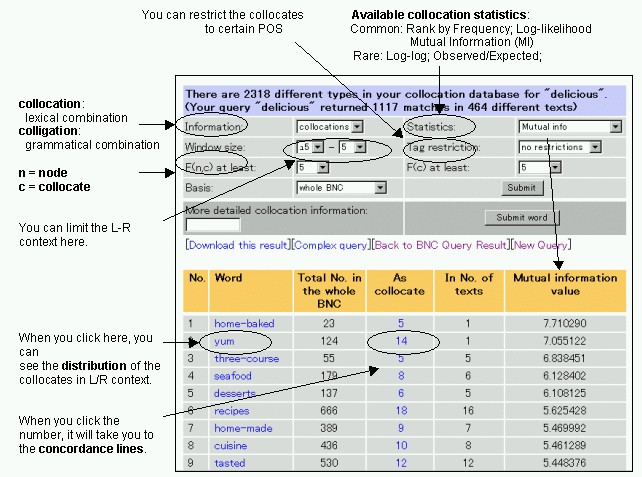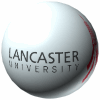Collocations:
"Delicious" and "tasty":
how do they behave with other words?
We will now look look at collocation function of BNCweb. For this, we will consider the
behaviour of the near-synonymous words, "delicious" and "tasty".
Do you think the word delicious is used in different contexts from the word
tasty? Can you think of particular words which co-occur with either of them? What is a main semantic difference
between the two?
Your task is to search the two words delicious and tasty, and find collocates
to identify semantic differences between the two. In order to do this, we will use the Collocation function of BNCweb.
If you are not already logged into BNCweb, you will need to log in now.

- First, search for the word delicious.
How many times does it occur?
How many texts does it appear in?
What is its normalised frequency?
- Sort the concordance lines by R1 to see what words follow delicious. Then look at the left context by sorting
the lines by L1.
- Now select Collocations and press [Go!]
- Press [Submit]. It will produce a collocation database.
- You will get a screen looking something like this screenshot. Try out the functions as described below.

Mutual information tends to pick up characteristic collocations regardless of
the absolute frequencies of the collocates.
Log-likelihood looks quite similar to Rank by Frequencies, but the scores are more reliable in that they
take into account the absolute frequency of each collocate.
Log-log is somewhat in the middle of MI and Log-likelihood.
Observed/Expected is another measure which is used as the basis of Chi-square and Log-likelihood. It also
take into account the absolute frequency of each collocate.
- To make things easy, letís just look at what nouns the word delicious modifies. Change the settings
as follows and then obtain the collocation lists:
- Limit the Window size to "+1" and "+1". This will pick up the collocates which appear in
the R1 (first word after delicious) only.
- Limit the Tag to any noun.
- Choose Log-likelihood for statistics.
- Follow steps 1 to 6 for the word tasty and analyse your results. Can you find any difference in the way
these two words are used in context?
Look at the list of words below. Which collocate with delicious? Which collocate
with tasty? Do any collocate with both words?
| meal |
food(s) |
smell |
| recipes |
dishes |
seafood |
| monster* |
sensation |
lunch |
| cakes |
morsel(s) |
treat |
| titbits |
snack(s) |
ideas |
| bread |
treble |
prizes |
| |
salad |
|
*"Delicious Monster" seems to be the name of a band (?).
What observation can you make about the two sets of collocates?
Extra Exercises
- What are the collocates of the words oppressive and repressive? From looking at the collocates, do the words have similar or different uses?
- Examine the collocates of distance. Then carry out searches of distance as a noun (distance=NN1) and distance as a verb (distance=VVI). How do the collocates differ in each case?
|



 WordSmith
WordSmith BNCweb
BNCweb Intro to BNCweb
Intro to BNCweb More on BNCweb
More on BNCweb Refining BNCweb Queries
Refining BNCweb Queries DIY Corpora
DIY Corpora



